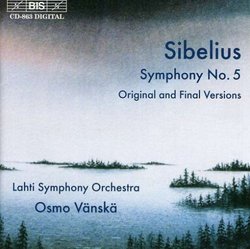| All Artists: Jean Sibelius, Osmo Vänskä, Lahti Symphony Orchestra Title: Sibelius: Symphony No. 5 (Original and Final Versions) Members Wishing: 0 Total Copies: 0 Label: Bis Release Date: 8/7/2000 Album Type: Import Genre: Classical Styles: Historical Periods, Modern, 20th, & 21st Century, Symphonies Number of Discs: 1 SwapaCD Credits: 1 UPCs: 789368610723, 7318590008638 |
Search - Jean Sibelius, Osmo Vänskä, Lahti Symphony Orchestra :: Sibelius: Symphony No. 5 (Original and Final Versions)
 | Jean Sibelius, Osmo Vänskä, Lahti Symphony Orchestra Sibelius: Symphony No. 5 (Original and Final Versions) Genre: Classical
|
Larger Image |
CD Details |
CD ReviewsAn important cultural operation Massimo Marullo | Messina, Italy | 01/08/2000 (5 out of 5 stars) "I have recently reviewed the CD containing the symphonies no 2 and 3 of Sibelius, interpreted by the Lahti Symphony Orchestra conducted by Osmo Vanska. In the present CD is present the fifth symphony in the two versions: the original one of 1915 and the definitive one of 1919. I can to fix what I 've written in the preceding review, because this recording concerns a really innovative and idiomatic reading of Sibelius' work, showing once more as the interpretative approach of Vanska and the Lahti Symphony Orchestra really represents today the point of reference in the interpretative survey of the works of the Finnish composer. The interpretation of the fifth symphony appears intense, with its themes perfectly graven in a "northern" atmosphere, realistically involving and deprived of the rhetoric that characterizes the interpretation of some famous conductors. Of absolute interest, in this CD, is the presence of the original version of the fifth symphony which, though appearing rather dispersive and less finished compared to the definitive version, it contains some harmonic and compositive boldness that give new lights about the knowledge of the creative processes of Sibelius. In conclusion, it can be affirmed that this CD, for the reasons above described, represents a cultural operation of great value and importance." A very interesting experience G. Stewart | Chesapeake, VA USA | 02/19/2009 (4 out of 5 stars) "Sibelius is one of the most underrated and unappreciated composers, not only from the his time, ever. His genius manifests itself in symphony, song and chamber. His 5th symphony, his greatest offering, in my humble opinion (and contrary to dear Sibelius' own favorite), is a magnificent display of the marriage of the sections of the orchestra. Hearing the original composition offers a glimpse in to what Sibelius' process of composition looked like, but more importantly, it offers a glimpse at his ability to ammend his own work; to cut and paste in order to create a final opus. The dissonance in the original composition is quite astonishing considering the glorious flow of the final version and it took some getting used to, but I find the original to be enjoyable. Hearing it, in contrast to the final offering, is an interesting experience, the differences, shocking. I find Sibelius' 5th to be his masterpiece, a wonder that is both emotionally uplifting and somber. This CD is most likely geared toward the Sibelius fan looking for something unusual. Somone that is new to Sibelius should explore his vast repetoire before settling in to something like this. One who knows and loves Sibelius should find this to be a treat, a peek at the work in progress of Sibelius' crowning gem. The Lahti, led by Osmo Vanska, perform beautifully and their interpretation of the final version ranks with my favorites; I have nothing with which to compare the original version, but the performance there is amazing as well. Enjoy!" Sibelius Symphony No. 5 mousefan | 02/15/2008 (5 out of 5 stars) "Recently I was at a symphony orchestra program where I heard Sibelius' Symphony No. 5. On the way home and all the next day the melody was running through my mind. I wanted to purchase this symphony and researched the reviews and discovered there is a 1915 version and a 1919 version. I've been listening to classical music all of my life and can't express any technicalities, but when I hear something I like, I buy it. This one is good because it has both versions. Both are excellent and the duration is approximately a half-hour for each version, so I love them both on one CD."
|

 Track Listings (7) - Disc #1
Track Listings (7) - Disc #1